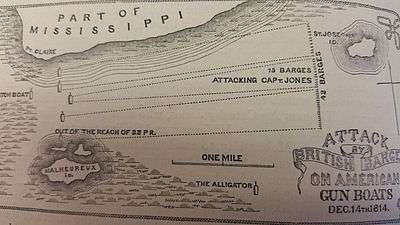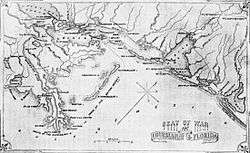Battle of Lake Borgne
The Battle of Lake Borgne was a battle between the Royal Navy and Royal Marines on one side and the U.S. Navy and U.S. Marines on the other in the American South theatre of the War of 1812. It occurred on December 14, 1814 on Lake Borgne, and the British victory allowed them to launch an offensive upon New Orleans ten days later.

Background
The failed British attack in September on Fort Bowyer prevented the British from captured Mobile, Alabama, and moving to cut off U.S. trade via land towards the Mississippi River. Next, the British decided to attack New Orleans and the Americans began receiving warnings of a British fleet approaching Louisiana. The warnings reached Commodore Daniel Patterson of the New Orleans Squadron, who immediately began to assemble any and all types of naval defenses to protect the state's waterways and naval ports. When the British forces under Admiral Alexander Cochrane arrived off the Louisiana coast on December 9, Patterson dispatched Lieutenant Thomas ap Catesby Jones and a small flotilla to patrol Lake Borgne. The American force consisted of five Jeffersonian gunboats - No. 156, No. 163, No. 5, No. 23, and No. 162 - the schooner USS Sea Horse with Sailing-Master Johnson commanding, and two sloops-of-war, USS Alligator and USS Tickler, serving as tenders. Gunboat No. 156, the flagship of the squadron, mounted one long 24-pounder, four 12-pounder carronades, and four swivel guns. She had a crew of forty-one men. In all, the squadron comprised 245 men, sixteen long guns, fourteen carronades, two howitzers and twelve swivel guns.
Vice Admiral Sir Alexander Cochrane, British Commander-in-Chief of the North American Station, ordered HMS Seahorse, Armide and Sophie from Pensacola to Lake Borgne. They were to proceed to the Bayou Catalan, or De Pecheurs, at the head of the lake and 60 miles (97 km) from the troopship anchorage. This was to be the disembarkation point for the attack on New Orleans. The three British vessels reported that as they passed Cat Island, Mississippi, two American gunboats had fired at them. Furthermore, lookouts on the masts had seen three more. When the fleet arrived on December 11, Cochrane decided to hunt out the Americans.
Cochrane put all the boats of the British fleet under the command of Commander Nicholas Lockyer of Sophie, with orders to find and defeat the American flotilla. The boats came from Tonnant, Norge, Bedford, Royal Oak, Ramillies, Armide, Cydnus, Seahorse, Trave, Sophie, Belle Poule, Gorgon, Manly and Meteor. The British deployed forty-two longboats, launches and barges with one 12, 18 or 24 pounder carronade each, as well as three gigs, each mounting a long brass 12 pounder cannon. The force consisted of some 1200 sailors and Royal Marines. At night on December 12, the British boats, under Lockyer, set off to enter Lake Borgne. Before reaching Lake Borgne, they encountered the one gun schooner Sea Horse. She was on a mission to destroy a powder magazine at Bay St. Louis in order to prevent its capture by the Royal Navy. The schooner, with the protection of a shore battery, fought off two of Lockyer's longboat attacks but then was burnt later that night to prevent the main British fleet from capturing her.
Battle
After rowing for about thirty-six hours, the British located the five American vessels drawn up in line abreast to block the channel between Malheureux Island and Point Claire on the mainland. As the British advanced, they spotted Alligator and immediately sent a few longboats under Roberts to cut her off and the British quickly captured her. At 10 o'clock on the morning of December 14, the boats had closed to within long gunshot by St. Joseph's Island. At this point Lockyer ordered the boats' crews to breakfast. Lockyer formed the boats into three divisions. He took command of the first and gave Montresor of Manley command of the second and Roberts of Meteor command of the third. When the British had finished their breakfast they returned to their oars and pulled up to the enemy. The main battle came at 10:30 am. The Americans in the gunboats saw the British rowing towards them and opened fire while the boats were still out of reach. The British were rowing against a strong current and under a heavy fire of round and grapeshot.
The Americans fired as many times as possible before the range closed. They were able to sink two of the attacking longboats and damaged many others. They killed or wounded a number of the longboat crews in the process, including most of the men in Lockyer's boat. Eventually the range closed and the British sailors and marines began to board the American vessels. Lockyer personally boarded Gunboat No. 156, Jones's ship. In the close quarters combat the two sides used cutlasses, pikes, bayonets and muskets. Both Lockyer and Jones sustained severe wounds. The British captured Gunboat No. 156 and turned her guns against her sister ships. The gunboat fired her broadsides and assisted the capture of the remaining American craft. One by one, the British took the other four American gunboats. Boarding and capturing the entire American flotilla took five minutes. Tickler, a small fifty ton sloop anchored a short distance behind the five gunboats, watched the battle but stayed out of the fight as Jones ordered. When her captain saw the British had captured all five American gunboats, he scuttled and burned his vessel. It is not known if the crew was captured or escaped to New Orleans.
Aftermath

The engagement lasted about two hours, though the actual hand-to-hand combat lasted only five minutes. The British forced the outnumbered American seamen to surrender. The British won control of the lakes, but the battle gave General Andrew Jackson more time to strengthen his defenses. The Americans lost their entire fleet present alongside 41 killed or wounded and 86 captured. Jones was made a prisoner of war for three months and would later be decorated for his bravery in delaying the British advance. The British casualties were 94 killed and wounded, along with 2 boats sunk. Cochrane rated the captured flotilla as the equivalent of a 36-gun frigate and appointed Lockyer to its command as soon as his wounds permitted. Montresor took command pro tem; in March 1815, Lockyer received promotion to post captain.
The British took the five gunboats into service under the names Ambush (or Ambush No. 5), Firebrand, Destruction, Harlequin and Eagle. Several of these vessels remained in Royal Navy service into June 1815, and at least one perhaps beyond.[2][Note 1][Note 2]
Lake Borgne would become the landing zone for British forces preparing to attack New Orleans. After the population of the city learned of the engagement on Lake Borgne, panic overtook some of New Orleans' population; so, Andrew Jackson declared martial law.
Medal
In 1847 the Royal Navy issued a clasp (or bar) for the Naval General Service Medal marked "14 Dec. Boat Service 1814," to survivors of the battle who wanted to claim the clasp. In all, 205 survivors claimed it.[5]
Notes
- A first-class share of the prize money was worth £34 12s 9¼d; a sixth-class share, that of an ordinary seaman, was worth 7s 10¾d.[3]
- 'Notice is hereby given to the officers and companies of His Majesty's ships Aetna, Alceste, Anaconda, Armide, Asia, Bedford, Belle Poule, Borer, Bucephalus, Calliope, Carron, Cydnus, Dictator, Diomede, Dover, Fox, Gorgon, Herald, Hydra, Meteor, Norge, Nymphe, Pigmy, Ramillies, Royal Oak, Seahorse, Shelburne, Sophie, Thames, Thistle, Tonnant, Trave, Volcano, and Weser, that they will be paid their respective proportions of prize money.' [4]
References
- Citations
- Lossing, Benson (1868). The Pictorial Field-Book of the War of 1812. Harper & Brothers, Publishers. p. 1026.
- Paullin and Paxson (1914), p.436.
- "No. 17730". The London Gazette. 28 July 1821. p. 1561.
- "No. 17730". The London Gazette. 28 July 1821. p. 1561.
- "No. 20939". The London Gazette. 26 January 1849. p. 247.
- Bibliography
- Stoltz, Joseph F. (2014) The Gulf Theatre in the War of 1812 (https://web.archive.org/web/20181016125910/https://josephfstoltz.com/new-orleans-campaign/)
- Paullin, Charles Oscar and Frederic Logan Paxson (1914) Guide to the materials in London archives for the history of the United States since 1783. (Carnegie Institution of Washington).
- Gene A. Smith, Thomas ap Catesby Jones, Commodore of Manifest Destiny (Annapolis, MD: Naval Institute Press, 2000) ISBN 1-55750-848-8
- USS KIDD Veterans Memorial—Louisiana's Military Heritage—The Battle of Lake Borgne at www.usskidd.com/battles-lakeborgne.html **Copyright 1997-2007 by Louisiana Naval War Memorial Commission**
- The Glorious Eighth of January — colorful account by Grace King
- The Battle of New Orleans — account by Theodore Roosevelt
- Siege of Fort St. Philip — eyewitness accounts, as published in the Louisiana Historical Quarterly
